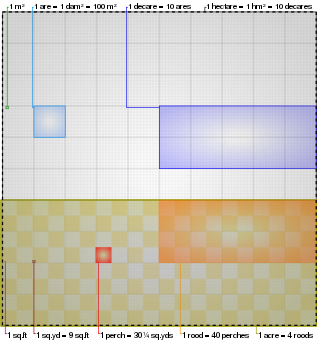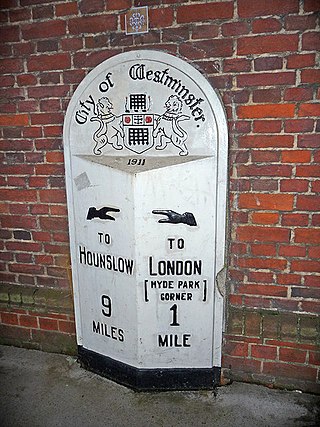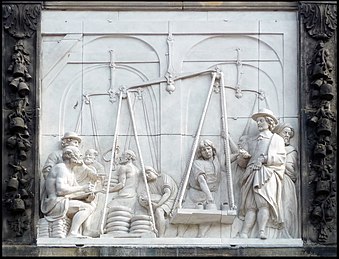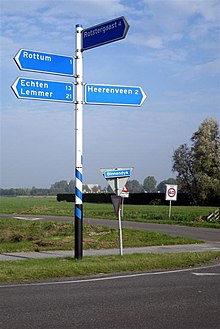
The acre is a unit of land area used in the British imperial and the United States customary systems. It is traditionally defined as the area of one chain by one furlong, which is exactly equal to 10 square chains, 1⁄640 of a square mile, 4,840 square yards, or 43,560 square feet, and approximately 4,047 m2, or about 40% of a hectare. Based upon the international yard and pound agreement of 1959, an acre may be declared as exactly 4,046.8564224 square metres. The acre is sometimes abbreviated ac but is usually spelled out as the word "acre".

The inch is a unit of length in the British Imperial and the United States customary systems of measurement. It is equal to 1/36 yard or 1/12 of a foot. Derived from the Roman uncia ("twelfth"), the word inch is also sometimes used to translate similar units in other measurement systems, usually understood as deriving from the width of the human thumb.

The mile, sometimes the international mile or statute mile to distinguish it from other miles, is a British imperial unit and United States customary unit of distance; both are based on the older English unit of length equal to 5,280 English feet, or 1,760 yards. The statute mile was standardised between the Commonwealth of Nations and the United States by an international agreement in 1959, when it was formally redefined with respect to SI units as exactly 1,609.344 metres.

The kilometre, spelt kilometer in American English and Philippine English, is a unit of length in the International System of Units (SI), equal to one thousand metres. It is the preferred measurement unit to express distances between geographical places on land in most of the world; notable exceptions are the United States and the United Kingdom where the statute mile is used.
The ounce is any of several different units of mass, weight, or volume and is derived almost unchanged from the uncia, an Ancient Roman unit of measurement.

The foot is a unit of length in the British imperial and United States customary systems of measurement. The prime symbol, ′, is commonly used to represent the foot. In both customary and imperial units, one foot comprises 12 inches, and one yard comprises three feet. Since an international agreement in 1959, the foot is defined as equal to exactly 0.3048 meters.
The rod, perch, or pole is a surveyor's tool and unit of length of various historical definitions. In British imperial and US customary units it is defined as 16+1⁄2 feet, equal to exactly 1⁄320 of a mile, or 5+1⁄2 yards, and is exactly 5.0292 meters. The rod is useful as a unit of length because integer multiples of it can form one acre of square measure (area). The 'perfect acre' is a rectangular area of 43,560 square feet, bounded by sides 660 feet long and 66 feet wide or, equivalently, 40 rods by 4 rods. An acre is therefore 160 square rods or 10 square chains.
The following systems arose from earlier systems, and in many cases utilise parts of much older systems. For the most part they were used to varying degrees in the Middle Ages and surrounding time periods. Some of these systems found their way into later systems, such as the Imperial system and even SI.

An ell is a northwestern European unit of measurement, originally understood as a cubit. The word literally means "arm", and survives in the form of the modern English word "elbow" (arm-bend). Later usage through the 19th century refers to several longer units, some of which are thought to derive from a "double ell".
A morgen was a unit of measurement of land area in Germany, the Netherlands, Poland, Lithuania and parts of the Dutch Overseas Empire, such as South Africa. The size of a morgen varies from 1⁄2 to 2+1⁄2 acres. It was also used in Old Prussia, in the Balkans, Norway and Denmark, where it was equal to about two-thirds acre (2,700 m2).
The units of measurement in use in Denmark are currently part of the metric system. A variety of other historical weights and measures have been employed throughout the nation's history.
Traditional Swedish units of measurement were standardized by law in 1665, prior to which they only existed as a number of related but differing local variants. The system was slightly revised in 1735. In 1855, a decimal reform was instituted that defined a new Swedish inch as 1⁄10 Swedish foot. Up to the middle of the 19th century, there was a law allowing the imposition of the death penalty for falsifying weights or measures. After a decision by the parliament in 1875, Sweden adopted the metric system on 22 November 1878, with a ten-year transition period until 1 January 1889.

The earliest recorded systems of weights and measures originate in the 3rd or 4th millennium BC. Even the very earliest civilizations needed measurement for purposes of agriculture, construction and trade. Early standard units might only have applied to a single community or small region, with every area developing its own standards for lengths, areas, volumes and masses. Often such systems were closely tied to one field of use, so that volume measures used, for example, for dry grains were unrelated to those for liquids, with neither bearing any particular relationship to units of length used for measuring cloth or land. With development of manufacturing technologies, and the growing importance of trade between communities and ultimately across the Earth, standardized weights and measures became critical. Starting in the 18th century, modernized, simplified and uniform systems of weights and measures were developed, with the fundamental units defined by ever more precise methods in the science of metrology. The discovery and application of electricity was one factor motivating the development of standardized internationally applicable units.
The traditional Polish units of measurement included two uniform yet distinct systems of weights and measures, as well as a number of related systems borrowed from neighbouring states. The first attempt at standardisation came with the introduction of the Old Polish measurement [system], also dubbed the Warsaw system, introduced by a royal decree of December 6, 1764. The system was later replaced by the New Polish measurement [system] introduced on January 1, 1819.
Taiwanese units of measurement are the customary and traditional units of measure used in Taiwan. The Taiwanese units formed in the 1900s when Taiwan was under Japanese rule. The system mainly refers to Japanese system. The measurement refers to the traditional size of a Japanese flooring mat called a Tatami mat which were positioned to completely cover the floor of traditional Japanese homes, therefore it became a convenient measurement tool as mat area was standardised hundreds of years ago. In Taiwan the measurement units were pronounced in Taiwanese Hokkien and Hakka before World War II and adopted by the Mandarin-speaking immigrants from China in 1949. Today, the Taiwanese units are used exclusively, in some cases alongside official SI units, and in other cases they have been replaced by SI.
A Cape foot is a unit of length defined as 1.0330 English feet found in documents of belts and diagrams relating to landed property. It was identically equal to the Rijnland voet and was introduced into South Africa by the Dutch settlers in the seventeenth and eighteenth century. Its relationship to the English foot was clarified in 1859 by an Act of the government of the Cape Colony, South Africa. It was used for land surveying and title deeds in rural areas of South Africa apart from Natal and was also for urban surveying and title deeds in the Transvaal. There were 144 square Cape feet in one Cape rood and 600 Cape roods in one morgen.

The name Rijnland means "Rhineland" in Dutch. When referring to the Rhine in Germany, "Rijnland" has the same meaning as "Rhineland" in English or "Rheinland" in German. However, "Rijnland" has a specific, different meaning in a Dutch context - the area along the Oude Rijn.
A number of units of measurement were used in Hungary to measure length, area, volume, and so on. The metric system was adopted in Hungary in 1874 and has been compulsory since 1876.
A number of units of measurement were used in Iceland to measure length, mass, area, capacity, etc. Since 1907, the metric system has been compulsory in Iceland.
A number of units of measurement were used in South Africa to measure quantities like length, mass, capacity, etc. The Imperial system of measurements was made standard in 1922 and the metric system was adopted in 1961.










